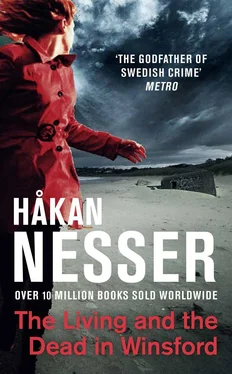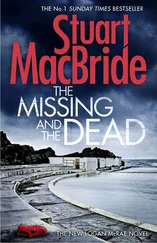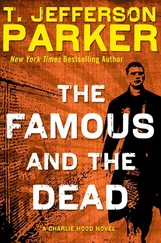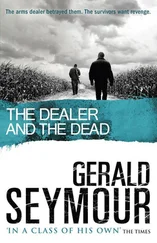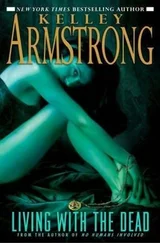Håkan Nesser - The Living and the Dead in Winsford
Здесь есть возможность читать онлайн «Håkan Nesser - The Living and the Dead in Winsford» весь текст электронной книги совершенно бесплатно (целиком полную версию без сокращений). В некоторых случаях можно слушать аудио, скачать через торрент в формате fb2 и присутствует краткое содержание. Год выпуска: 2013, Издательство: Mantle, Жанр: Криминальный детектив, на английском языке. Описание произведения, (предисловие) а так же отзывы посетителей доступны на портале библиотеки ЛибКат.
- Название:The Living and the Dead in Winsford
- Автор:
- Издательство:Mantle
- Жанр:
- Год:2013
- ISBN:нет данных
- Рейтинг книги:4 / 5. Голосов: 1
-
Избранное:Добавить в избранное
- Отзывы:
-
Ваша оценка:
- 80
- 1
- 2
- 3
- 4
- 5
The Living and the Dead in Winsford: краткое содержание, описание и аннотация
Предлагаем к чтению аннотацию, описание, краткое содержание или предисловие (зависит от того, что написал сам автор книги «The Living and the Dead in Winsford»). Если вы не нашли необходимую информацию о книге — напишите в комментариях, мы постараемся отыскать её.
The Living and the Dead in Winsford — читать онлайн бесплатно полную книгу (весь текст) целиком
Ниже представлен текст книги, разбитый по страницам. Система сохранения места последней прочитанной страницы, позволяет с удобством читать онлайн бесплатно книгу «The Living and the Dead in Winsford», без необходимости каждый раз заново искать на чём Вы остановились. Поставьте закладку, и сможете в любой момент перейти на страницу, на которой закончили чтение.
Интервал:
Закладка:
But my heart was racing, and it was some time before I managed to calm down. It occurred to me that perhaps I ought to buy a little CD-player. A reassuring voice or a saxophone that could soften up the darkness and the silence would no doubt be welcome. Dexter Gordon, perhaps? Or Chet Baker? Would it be possible to find something by Chet Baker in a music shop in Minehead or Dulverton? Or would I need to go to Exeter? That is the only town of any size in this neck of the woods, and if I have read the map correctly it should be possible to drive there in an hour and a half or two hours at the most.
I eventually fell asleep again, and began immediately to dream about the grey-white beach at Miȩdzyzdroje. Walking eastwards into the wind, and then that strange walk back again.
That strange walk back again.
6
Martin spent three summers in all at Samos. 1977, 1978 and 1979. The literary jamboree continued for another five years or so, but Tom Herold and Bessie Hyatt left both their house and the Mediterranean island in September 1979. Bessie’s second novel — Men’s Blood Circulation — was published a month later that same autumn, by which time the pair had settled down just outside Taza in Morocco, and they stayed there until Bessie’s suicide in April 1981.
For a few weeks in July-August 1980 Martin was a guest at their new home in Morocco: I stayed behind in Stockholm, awaiting the birth of Gunvald. We had moved into our first shared accommodation, a three-roomed flat in Folkungagatan, in May. I don’t know exactly what happened during those weeks in Taza, but something significant did. When Martin came back to Sweden he had changed in a way that I didn’t really understand until several years later. Although we were about to become parents, we hadn’t known each other all that long; my pregnancy was rather complicated, and I was concentrating on what was happening to my own body — the internal changes, not the external ones.
In any case, we didn’t talk much about Taza. Not before Bessie Hyatt’s suicide, and not after it. Quite a lot was written about Herold and Hyatt during those years, and an English company even began making a film about their lives — with two relatively prominent actors taking the leading roles — but the project eventually came to a halt for some unknown reason. Possibly a shortage of money, or possibly a threat of legal action from Tom Herold’s lawyers.
But Martin never published anything about it, not a single word, and when I asked him about that long afterwards — more by chance than out of real interest — he simply answered that he was bound by certain promises. No, he didn’t answer , he implied — looking back now, I’m quite sure that is the fact of the matter.
Tom Herold kept both his life and his reputation. He continued living in Morocco — but not in Taza — until the beginning of the twenty-first century, when he moved back home to England. He published over twenty collections of poetry, three novels and a sort of posthumous autobiography, which appeared six months after his death in 2009. He also directed and produced two self-indulgent long films during the nineties; but his fame reached its peak for a broader and non-literary public in May 2003, when he decapitated a young burglar in his Dorset home with the aid of a thousand-year-old Arab scimitar. As the burglar was armed with both a knife and a gun, Herold was cleared of any criminal offence by the subsequent trial.
He also managed to fit in another short marriage — between 1990 and 1995 or thereabouts. The woman in question was a young Moroccan by the name of Fatima: but there were no children from this relationship either.
For the whole of his life Tom Herold was constantly being written about, despite the fact that he deliberately avoided publicity. He never gave interviews, not even when he was being hounded by writers and journalists of all conceivable persuasions. Especially after the suicide of Bessie Hyatt he was subjected to what can only be called a witch-hunt. He was accused in several contexts of being guilty of his young wife’s death, and there was much speculation about the use of drugs and various occult rituals. But Herold never commented at all about the relationship between himself and his wife. Needless to say, when his posthumous memoirs were published almost thirty years after Bessie’s death, expectations were very high. It was unclear if he had given permission for the book to be published before he died, or if it was his publisher who had taken the matter into his own hands. Herold had no heirs at all, and had not made a will. He was killed by a malignant colon cancer, and according to his few friends his final years had been characterized by pain and melancholy.
In any case, The Sum of My Days was a failure, from both a literary and a commercial point of view. The reviews were consistently lukewarm, and those who had been hoping for sensational revelations, especially in connection with his years together with Bessie Hyatt, were disappointed. The so-called memoirs turned out to be mainly a series of neutral observations of nature without much in the way of subtlety or finesse. The only chapters with a more personal touch were about some summers in his childhood, spent on a farm in Wales in the company of a female cousin. Bessie Hyatt was mentioned by name twice in the whole book, and their marriage that inspired so much speculation and gossip was allocated about three-and-a-half pages. Moreover, most readers thought the book was badly edited, and although Herold was such a familiar name in large parts of the world, there was never any question of its becoming an international success.
Thirty years after Bessie Hyatt’s death, her two novels — Before I Fall and Men’s Blood Circulation — had achieved worldwide sales of over twenty-five million copies. Roughly speaking that is about ten times as many as Herold could manage.
‘I understand,’ Eugen Bergman had said that October afternoon in Sveavägen. ‘And how extensive is your material, approximately?’
‘A thousand pages,’ said Martin with a shrug. ‘Give or take a hundred. And I need six months to get it into shape. Maybe more, but let’s say six months to start with.’
‘Hm,’ said Bergman.
‘Morocco,’ said Martin, giving me a look that was intended to mean we were in agreement. That we had discussed the matter, and were in the same boat. The same unsinkable flat-bottomed rowing boat of marriage in heavy seas. There was no end to the images implied, and I suddenly felt sick.
‘I still have quite a few contacts down there, and it’s always an advantage to be in the right place.’
‘Hm,’ said Bergman again, heaving himself up from his desk chair and walking over to the window, where he gazed out for a while at Adolf Fredrik Church. Swayed back and forth in a way that one has to call characteristic. Hands clasped behind his back. Hair all over the place. It was a lovely autumn day out there. Martin signalled to me that I should say nothing, and I looked around for somewhere suitable if I found I really did need to throw up. I decided on the waste-paper basket at the side of the desk.
‘And what about Bessie Hyatt? Those years?’ He muttered that in a low voice, almost as an afterthought, without turning round.
‘Of course,’ said Martin in his typically quiet, non-committal tone of voice. ‘That’s what it’s all about after all, isn’t it?’
He could just as well have been commenting on how to cope with heartburn, or what kind of roof would be most appropriate for his outside loo. I started to feel less like throwing up. Bergman went back to his desk and put on his glasses. Pushed them down to the tip of his nose and looked at us as if we were a picture puzzle he was on the point of solving. Or something like that.
Читать дальшеИнтервал:
Закладка:
Похожие книги на «The Living and the Dead in Winsford»
Представляем Вашему вниманию похожие книги на «The Living and the Dead in Winsford» списком для выбора. Мы отобрали схожую по названию и смыслу литературу в надежде предоставить читателям больше вариантов отыскать новые, интересные, ещё непрочитанные произведения.
Обсуждение, отзывы о книге «The Living and the Dead in Winsford» и просто собственные мнения читателей. Оставьте ваши комментарии, напишите, что Вы думаете о произведении, его смысле или главных героях. Укажите что конкретно понравилось, а что нет, и почему Вы так считаете.
